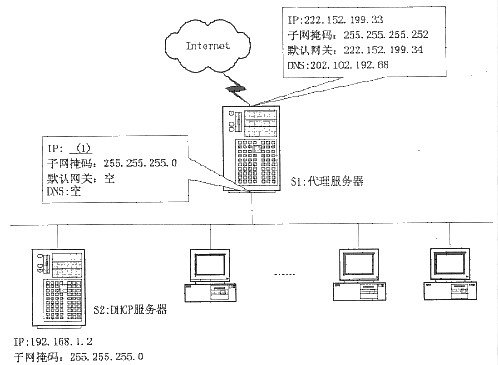阅读以下说明,回答问题1~5,将答案填入答题纸对应的 解答栏內。
[说明]
某公司有一个局域网,在ISP申请了Internet接入,接入方式是以太网,ISP分配给了一个固定的IP地址为222.152.199.33、子网掩码为255.255.255.252、默认网关为222.152.199.34、DNS为202.102.192.68。该公司有两台服务器,一台PC服务器S1作为代理服务器实现整个公司上网,代理服务器的操作系统是Linux,代理软件是squid;另一台PC服务器S2安装了DHCP服务,为内部客户机动态分配IP地址,拓扑图如下图所示。

下面分别是服务器S1的代理服务配置文件/etc/squid/squid.conf和服务器S2的DHCP服务配置文件/etc/dhcpd.conf的主要内容。
[s1的/etc/squid/squid.conf文件的主要内容]
http_port 8080
cache mere 194 MB
cache dir/home/squid/cache 4000 24 33
cache access log/usr/local/squid/logs/access.log
cache log /usr/local/squid/logs/cache.log
dns nameservers (2)
acl denydomain dstdomain foo.com.tw
acl all scr 0.0.0.0/0.0.0.0
http access deny denydomain
http access allow all
cache_mgr netsnake@263.net
[S2服务器/etc/dhcpd.conf文件的主要内容]
subnet 192.168.1.0 netmask 255.255.255.0{
range (3) ;
default-lease-time 86400;
max-lease-time 604800;
option subnet-mask 255.255.255.0;
option routers 192.168.1.1;
option broadcast-address 192.168.1.255;
option domain-name-servers 202.102.192.68;
}
| 代理服务器缓冲区放在哪里大小是多少 |
参考答案:
解析:/home/squid/cache、4000M代理服务器缓冲区放的位置和大小是由/etc/squid/squid.conf文件中cache_dir选项来指定的,同时该参数还可指定目录结构,定义方法是: CaChe dir <目录> <大小> <一级目录数><二级目录数> “目录”指明了该交换空间的顶级目录,“大小”定义了可用的空间总量,其单位是Mbytes。因此,在本题中,代理服务器缓沖区放在/home/squid/cache,大小为4000M。
